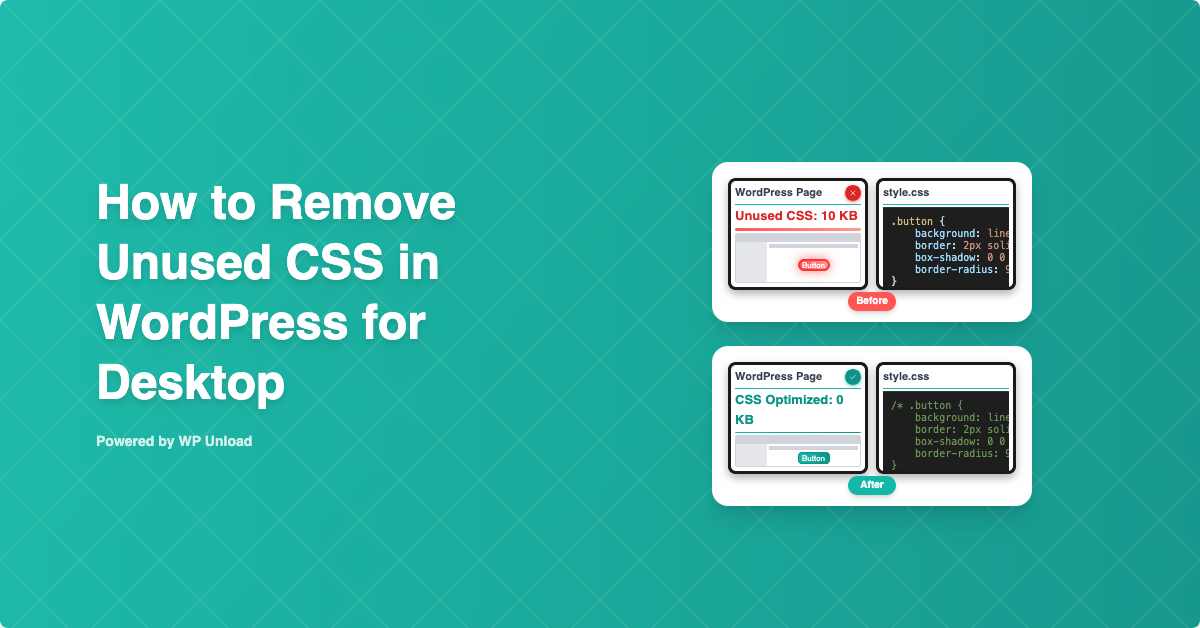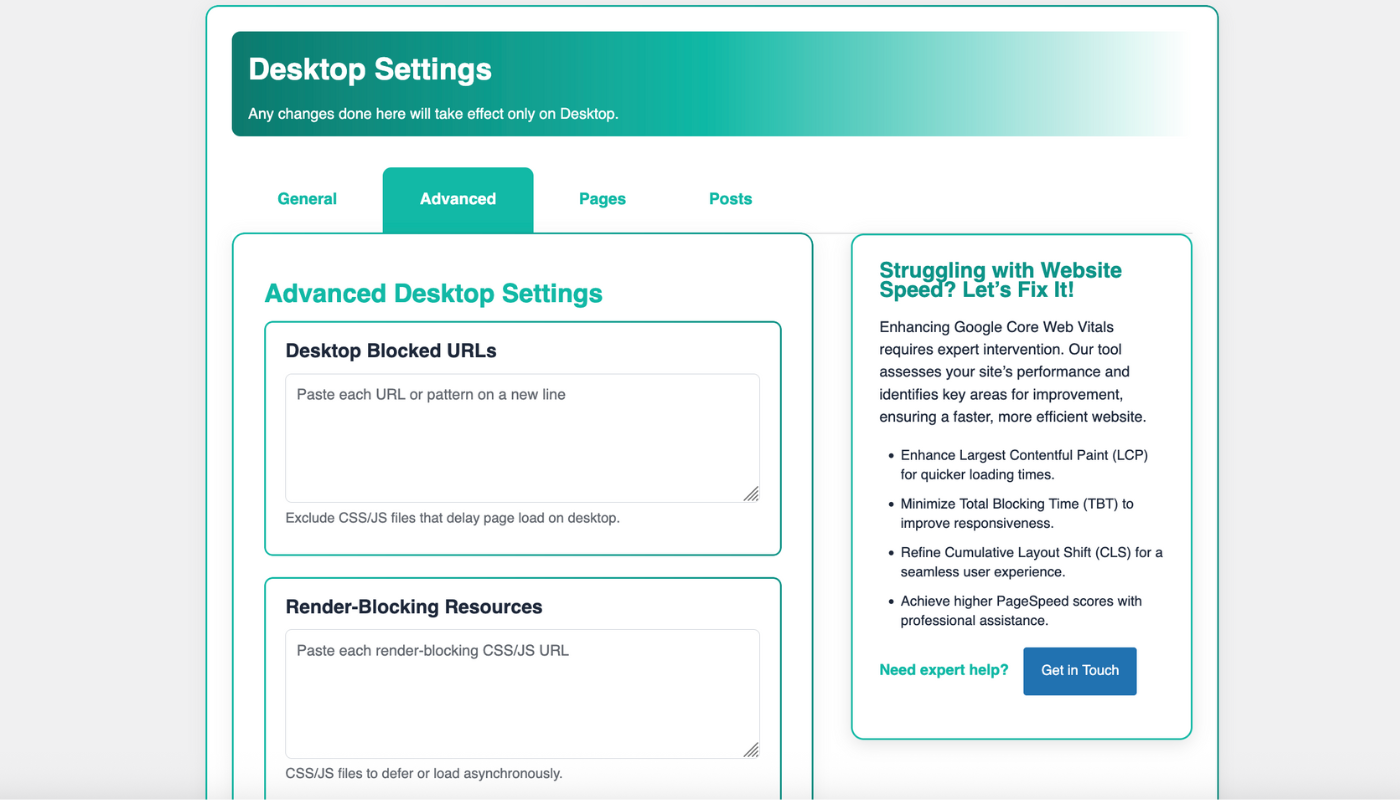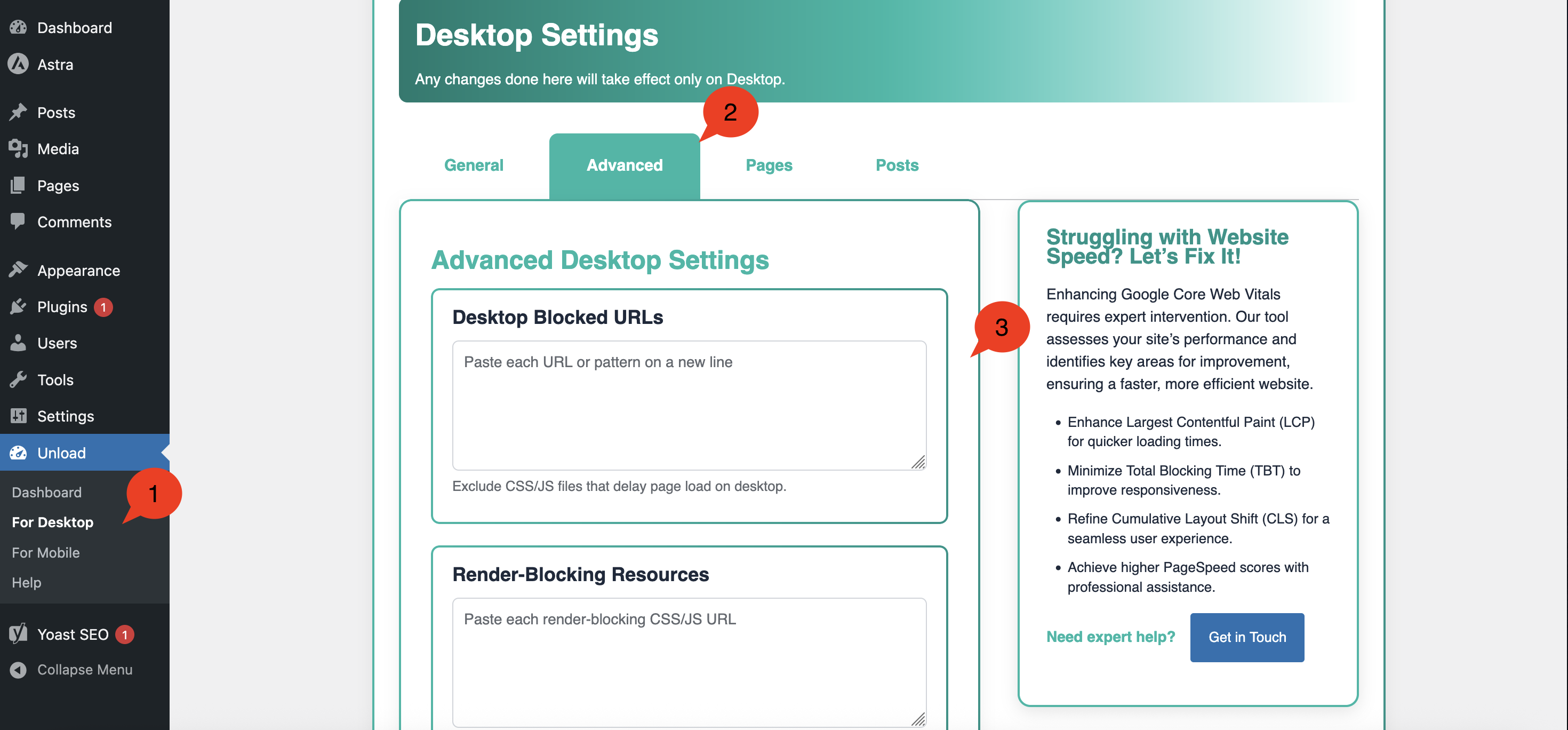Unused CSS—styles loaded but not used across your WordPress site on desktop—bloats pages, slows load times, and hurts SEO. Removing unused CSS in WordPress for desktop with WP Unload Assets trims this excess sitewide, speeds up rendering, and boosts Core Web Vitals like Largest Contentful Paint (LCP). This guide details how to remove unused CSS for all desktop pages, posts, and archives, with steps, screenshots, a video, and tips. For specific posts or pages, see our guides on post-specific CSS removal or page-specific CSS removal.
Why Remove Unused CSS in WordPress for Desktop?
Unused CSS, like a 50KB slider style on a desktop contact page, delays rendering and increases LCP. This harms user experience and SEO, as Google prioritizes fast desktop sites. Blocking 70KB of unused CSS can cut LCP by 0.8s across all desktop pages. WP Unload Assets’ “For Desktop” settings simplify this process, outperforming manual methods or plugins like WP Rocket.
Benefits of Removing Unused CSS with WP Unload Assets
- Faster Desktop Loads: A blog cut 70KB of CSS, reducing desktop LCP by 0.8s.
- Enhanced SEO: Improved LCP boosts rankings, per our Core Web Vitals guide.
- Desktop Precision: Targets desktop CSS sitewide, preserving mobile styles.
- No Coding Needed: One-click interface is beginner-friendly.
- Multisite Support: Optimizes desktop performance across networks.
Key Takeaway: Removing unused CSS in WordPress for desktop enhances speed, SEO, and user engagement.
Challenges of Not Removing Unused CSS
Unremoved CSS bloats every desktop page, delaying LCP and interactivity. This leads to poor PageSpeed Insights scores, higher bounce rates (up to 15%), and lower rankings. Dynamic themes and plugins make manual removal risky. WP Unload Assets automates desktop-only sitewide CSS removal, ensuring safe optimization.
How to Remove Unused CSS in WordPress for Desktop
Follow these steps to remove unused CSS in WordPress for desktop using WP Unload Assets (version 1.1.0), compatible with WordPress 6.3+ and themes like Astra or Divi.
Step 1: Install WP Unload Assets
Download from our homepage:
- Log in to your WordPress dashboard (
yourwebsite.com/wp-admin). - Go to Plugins > Add New > Upload Plugin.
- Upload the WP Unload Assets ZIP file and click Install Now.
- Activate the plugin to access the “WP Unload Assets” menu.
Step 2: Activate Your License
Unlock features:
- Navigate to WP Unload Assets in the admin sidebar.
- Enter your license key (e.g.,
xxxx-xxxx-xxxx-xxxxxxx) from your purchase email. - Click Activate License. A “License Status: Active” message confirms success.
Proof: The license screen enables desktop optimization tools.
Pro Tip: Back up your site and test on a staging environment.
Step 3: Access For Desktop Settings
In the WP Unload Assets dashboard:
- Go to WP Unload Assets > For Desktop.
- Explore options for desktop CSS optimization, complementing CSS preloading.
Proof: The “For Desktop” section centralizes desktop CSS controls.
Step 4: Remove Unused CSS
To remove unused CSS sitewide for desktop:
- In the For Desktop section, select Blocked URLs.
- Identify unused CSS (e.g.,
/wp-content/plugins/plugin/slider.css) using Chrome DevTools’ Coverage tab. - Add these URLs to the “Blocked URLs” field to prevent loading on desktop.
- Click Save Changes.
- Test by opening a desktop page, accessing Chrome DevTools (F12), and searching for the blocked file (e.g.,
slider.css) with Ctrl+F. If absent, removal is successful.
/* Before: Loaded on Desktop */
.slider { display: flex; } /* 50KB */
/* After: Blocked via WP Unload Assets */
Video Tutorial: How to Remove Unused CSS in WordPress for Desktop
Watch our video: Optimize Desktop WordPress by Removing Unused CSS!
This video demonstrates Step 4, showing how to block unused CSS in the “For Desktop” section.
Troubleshooting Common Issues
- Layout Breaks: Enable “Safe Mode” to exclude dynamic CSS (e.g., Elementor styles).
- Changes Not Visible: Clear cache with WP Unload Assets’ “Purge Cache” button.
- Plugin Conflicts: Exclude essential CSS (e.g., WooCommerce styles) using DevTools.
/* Identifying Unused CSS with Chrome DevTools */
1. Open Chrome DevTools (F12).
2. Go to Sources > Coverage.
3. Record and check unused CSS files (e.g., slider.css).
Key Takeaway: WP Unload Assets ensures safe desktop CSS removal.
Step 5: Analyze Unused CSS
Identify more unused CSS:
- Use Google PageSpeed Insights for “Remove unused CSS” warnings.
- In Chrome DevTools, go to Sources > Coverage, record a desktop page load, and note unused files.
- Add these to “Blocked URLs” in Step 4.
Proof: PageSpeed identified 60KB of unused desktop CSS, blocked to improve LCP.
Step 6: Verify Results
Test the impact:
- Run Google PageSpeed Insights to measure desktop LCP and FCP.
- Check desktop layouts in Chrome, Firefox, and Safari.
- Adjust blocked URLs if issues arise.
Proof: A site blocked 70KB of CSS, boosting its desktop PageSpeed score from 60 to 85 and cutting LCP by 0.8s.
Before and After Performance Results
Compare desktop PageSpeed Insights results:
- Before: Desktop LCP was 3.5s, with a PageSpeed score of 60.

- After: Desktop LCP dropped to 2.5s, boosting the PageSpeed score to 85.

How to Interpret: Lower desktop LCP enhances user experience and SEO. Check PageSpeed’s “Diagnostics” for more optimizations.
Advanced Tips to Optimize Your WordPress Site
Maximize desktop performance with WP Unload Assets:
Minify CSS
Reduce CSS sizes:
/* Before: 12KB */
.nav { margin: 10px; padding: 20px; }
/* After: 9KB */
.nav{margin:10px;padding:20px}
See our CSS minification guide.
Preload Critical CSS
Preload key desktop styles:
<link rel="preload" href="/wp-content/themes/theme/style.css" as="style">
Learn more in our CSS preloading guide.
Case Study: E-Commerce Store
An e-commerce store blocked 80KB of unused desktop CSS (e.g., carousel.css) sitewide. Desktop LCP dropped from 3.5s to 2.5s, increasing conversions by 15%.
Case Study: Freelancer’s Portfolio
A freelancer removed 90KB of unused desktop CSS, then minified and preloaded styles. Desktop LCP fell from 3.2s to 1.9s, boosting inquiries by 20%.
Key Takeaway: WP Unload Assets maximizes desktop performance.
Common Pitfalls to Avoid
Avoid:
- Over-Removing CSS: Excluding essential styles breaks layouts. Use “Safe Mode.”
- Ignoring Mobile: For mobile optimization, see our mobile CSS guide.
- Skipping Tests: Test desktop browsers with BrowserStack.
- Neglecting Bottlenecks: Pair with image preloading.
Why Choose WP Unload Assets?
WP Unload Assets excels at removing unused CSS in WordPress for desktop, offering:
- One-Click Simplicity: Block CSS in seconds.
- Desktop Control: Targets desktop sitewide, unlike post-specific tools.
- Core Web Vitals Focus: Improves LCP, FCP, and SEO.
- Multisite Ready: Optimizes desktop performance network-wide.
- Outperforms Competitors: More precise than WP Rocket or Autoptimize.
Start Speeding Up Your WordPress Site Today
Removing unused CSS in WordPress for desktop with WP Unload Assets transforms speed, SEO, and user experience. Its “For Desktop” feature, screenshots, video, and tools make optimization effortless. For specific posts or pages, check our post-specific or page-specific guides. Visit wpunload.com to get WP Unload Assets and optimize your desktop site!




